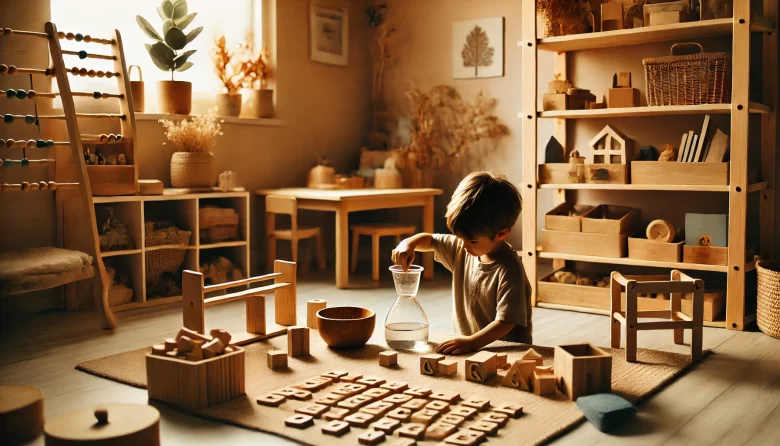The Montessori method is a child-centered educational approach that emphasizes independence, hands-on learning, and a prepared environment. Created by Dr. Maria Montessori, this method has been used in schools worldwide, but it can also be adapted for home education.
By integrating Montessori principles into your daily routine, you can foster your child’s natural curiosity, encourage self-directed learning, and create a structured yet flexible learning environment. In this article, we’ll explore how to apply Montessori methods at home, the benefits of this approach, and practical tips for setting up a Montessori-inspired learning space.
What Is the Montessori Method?
The Montessori method is based on the belief that children learn best when they are given the freedom to explore at their own pace. This approach values:
✅ Hands-on, experiential learning.
✅ A prepared environment that supports independence.
✅ Respect for the child’s natural curiosity and learning rhythm.
✅ A focus on practical life skills alongside academic subjects.
Montessori learning is structured yet flexible, allowing children to develop essential life skills while fostering a love for discovery.
Benefits of the Montessori Method at Home
Using Montessori principles in your home can help children:
✅ Develop independence and confidence.
✅ Enhance problem-solving and critical-thinking skills.
✅ Improve focus and concentration through self-directed activities.
✅ Learn through real-life experiences rather than passive instruction.
✅ Foster a deep sense of curiosity and love for learning.
🎯 Pro Tip: Montessori education is not about expensive materials—it’s about creating an environment that supports natural learning.
How to Create a Montessori Learning Environment at Home
A Montessori home environment is designed to encourage independence, exploration, and hands-on learning. Here’s how to set up your space:
Organize a Child-Friendly Learning Space
Children should be able to access materials independently to explore and learn at their own pace.
How to Set Up a Montessori Space:
🧸 Use low shelves so children can reach toys and learning materials.
📚 Keep books in an easy-to-access basket or shelf.
🎨 Organize art supplies in small containers for independent use.
🍽️ Arrange a child-sized table and chair for activities.
🎯 Pro Tip: Less is more—avoid clutter and rotate materials to keep the environment fresh and engaging.
Introduce Practical Life Activities
Practical life activities are a core component of Montessori education. These activities teach responsibility, coordination, and independence.
Examples of Montessori Practical Life Activities:
🍏 Pouring water from a small pitcher.
🧺 Folding and putting away clothes.
🥕 Washing fruits and vegetables.
🧼 Wiping a table after meals.
🛏️ Making the bed each morning.
🎯 Pro Tip: Choose activities that are meaningful and encourage real-world skills.
Use Hands-On Learning Materials
Montessori emphasizes sensory experiences, allowing children to learn through touch, movement, and exploration.
DIY Montessori Learning Materials:
🔢 Math: Use beans or buttons to practice counting.
🔤 Language: Create sandpaper letters for tracing.
🧩 Fine Motor Skills: Provide puzzles and threading beads.
🌎 Science: Allow children to explore nature by collecting leaves, observing insects, or growing plants.
🎯 Pro Tip: Let children manipulate objects and discover concepts naturally rather than memorizing facts.
Encourage Self-Directed Learning
In Montessori education, children choose activities based on their interests and curiosity. This promotes deeper engagement and a love for learning.
How to Support Self-Directed Learning:
✅ Provide open-ended toys (blocks, playdough, stacking cups).
✅ Observe your child’s interests and introduce related activities.
✅ Allow uninterrupted time for exploration and problem-solving.
✅ Let children repeat activities as many times as they like—repetition builds mastery.
🎯 Pro Tip: Avoid rushing to “correct” mistakes—allow children to figure things out on their own.
Establish a Montessori-Inspired Daily Routine
A predictable routine provides structure while allowing flexibility for self-directed activities.
Sample Montessori Daily Routine:
☀️ Morning: Practical life activities (e.g., setting the table, watering plants).
📚 Midday: Hands-on learning with Montessori materials (counting, sorting, puzzles).
🎨 Afternoon: Creative play (painting, music, sensory play).
🌳 Evening: Outdoor exploration or nature walks.
🎯 Pro Tip: Keep transitions smooth by using visual schedules or gentle verbal cues.
How to Foster Independence Using the Montessori Method
Allow Children to Do Things on Their Own
Encourage independence by allowing children to complete simple tasks without interference.
✅ Let them dress themselves, even if it takes longer.
✅ Allow them to prepare their snacks.
✅ Show them how to clean up after activities.
🎯 Pro Tip: Instead of fixing mistakes, guide children with gentle suggestions.
Follow the Child’s Interests
Montessori education is child-led, meaning activities should align with their natural curiosity.
How to Follow Your Child’s Lead:
🧐 Observe what excites them (e.g., animals, space, nature).
📝 Provide related books, toys, or experiments.
🔄 Rotate materials based on their current interests.
🎯 Pro Tip: Learning is most effective when children are genuinely interested in the subject.
Use Gentle Guidance Instead of Direct Instruction
Instead of giving commands, use gentle encouragement and questions to guide learning.
❌ Instead of: “Put that puzzle piece here.”
✅ Try: “Where do you think this piece might go?”
❌ Instead of: “You spilled! Let me clean it up.”
✅ Try: “Oops! What do we do when we spill something?”
🎯 Pro Tip: Giving children the chance to correct their own mistakes teaches responsibility.
Common Challenges and How to Overcome Them
“My child resists independent play.”
✔️ Solution: Start with short periods of self-directed play and gradually increase the time.
“I don’t have Montessori toys or materials.”
✔️ Solution: Use household items—spoons, cups, rice bins, and cardboard boxes all work well!
“It’s hard to let go and not interfere.”
✔️ Solution: Observe first before stepping in—trust that your child is capable!
🎯 Pro Tip: The goal is not perfection but growth—mistakes are part of the learning process.
Final Thoughts
The Montessori method is not just an educational approach—it’s a way of fostering independence, curiosity, and a love for learning. By creating a Montessori-inspired home environment, parents can support their child’s natural development and encourage self-confidence, problem-solving, and hands-on discovery.
With simple adjustments, any home can embrace Montessori principles, providing children with the tools they need to explore, learn, and grow at their own pace.




